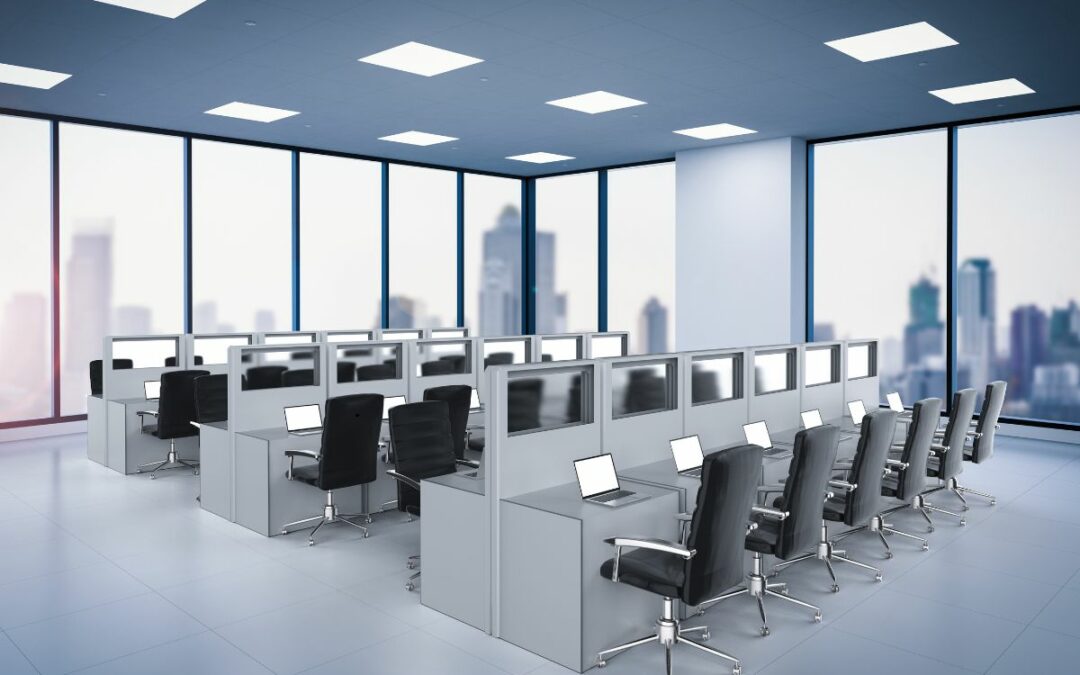They evolved from a revolutionary concept to increase productivity and privacy to a design element in contemporary office spaces.
This article explores office cubicle system benefits, drawbacks, and future, offering a comprehensive overview of their role in the workplace.
Benefits of Cubicle Workstations
Cubicle workstations offer a wide range of advantages that have kept them relevant in office furniture design:
- Privacy and Focus: Cubicles provide a degree of privacy that open office layouts often lack. Employees can focus on their tasks without the constant distractions of a completely open space.
- Personalization: Cubicles allow employees to personalize their space, making it more comfortable and conducive to productivity. A cubicle can accommodate personal items, decorations, and organizational tools.
- Noise Reduction: Cubicle partitions help reduce noise levels, creating a quieter work environment. This is particularly beneficial in offices where concentration is key.
- Cost-Effectiveness: From an employer’s perspective, cubicles are cost-effective. They are cheaper to install and maintain than constructing private offices for each employee.
- Flexibility: Cubicles can be easily reconfigured to accommodate team size or office layout changes. This flexibility is particularly valuable for companies that experience frequent growth or restructuring.
Drawbacks of Cubicle Workstations
Cubicles have benefits, but they also have disadvantages. These drawbacks lead some companies to reconsider their use of office floor plans.
- Isolation: One of the primary criticisms of cubicles is that they can create a sense of isolation among employees. The partitions that provide privacy can also hinder communication and collaboration.
- Monotony: The uniform appearance of cubicle farms can demoralize employees. The lack of variety and visual interest can lead to a sterile and uninspiring work environment.
- Limited Space: Although cubicles provide personal space, they are often limited. Employees may feel cramped and confined, negatively impacting their comfort and productivity.
- Hierarchy Perception: Cubicles can reinforce a hierarchical structure within an
organization.
Exploring Different Sizes of Cubicles in the Modern Office Environment
Cubicle workstations come in diverse sizes, each tailored to meet unique needs and preferences of employees and employers. The size of a cubicle can significantly impact productivity, comfort, and overall satisfaction in the workplace. This article examines the assorted sizes of cubicles, their applications, and the benefits they offer.
Small Cubicles (4’x4′ to 5’x5′)
Small cubicles typically range from 4 feet by 4 feet to 5 feet by 5 feet. They are made to save space and are commonly used in places where having as many workstations as possible is important.
Applications:
- Call Centers: Small cubicles are ideal for call centers where employees spend most of their time on the phone or using a computer.
- Administrative Tasks: These cubicles suit tasks that require minimal desk space, such as data entry or customer service.
Benefits:
- Space Efficiency: Small cubicles allow employees to fit more workstations in each area, maximizing office space.
- Cost-Effective: These cubicles are generally less expensive to install and maintain.
- Reduced Distractions: Employees can focus more on tasks with limited space for personal items.
Drawbacks:
- Limited Space: Employees may feel cramped and lack sufficient room for personal items or documents.
- Potential for Discomfort: Smaller workspaces can be less ergonomic, potentially leading to discomfort over prolonged periods.
Standard Cubicles (6’x6′ to 6’x8′)
Standard cubicles typically measure between 6 feet by 6 feet and 6 feet by 8 feet. They balance space efficiency and comfort, providing enough room for a computer, paperwork, and personal items.
Applications:
- General Office Work: This position suits various office tasks, such as helping customers and providing technical support.
- Individual Contributors: Ideal for employees who need a dedicated workspace but do not require extensive space for collaboration.
Benefits:
- Adequate Space: Standard cubicles provide enough room for most office tasks, ensuring comfort and productivity.
- Flexibility: You can customize these cubicles with additional storage or ergonomic furniture to enhance functionality.
- Moderate Privacy: They balance privacy and openness, allowing employees to focus while being accessible to colleagues.
Drawbacks:
- Potential for Isolation: While providing privacy, standard cubicles can create isolation if not designed thoughtfully.
- Space Utilization: They take up more space than small cubicles, which can be a disadvantage in densely populated offices.
Large Cubicles (8’x8′ to 10’x10′)
Large cubicles range from 8 feet by 8 feet to 10 feet by 10 feet. They provide ample space for employees who need to perform tasks that require more equipment, storage, or collaborative space.
Applications:
- Managers and Team Leaders: Large cubicles are suitable for employees who need additional space for meetings or supervisory tasks.
- Creative and Technical Work: This position is ideal for graphic designers, engineers, or architects who require multiple monitors, drafting tables, or extensive paperwork.
Benefits:
- Ample Space: Large cubicles offer ample space for various tasks, equipment, and personal items, enhancing comfort and productivity.
- Enhanced Privacy: These cubicles provide a higher level of privacy, which can benefit sensitive tasks or confidential work.
- Versatility: The additional space allows for versatile use, including small meetings or collaborative work within the cubicle.
Drawbacks:
- Higher Cost: Large cubicles are more expensive to install and maintain.
- Space Consumption: They take up significant floor space, which can be limited to smaller offices.
Executive Cubicles (10’x12′ and above)
Executive cubicles are the largest category, often resembling small private offices. They are usually 10 feet by 12 feet or bigger and made for employees who need a lot of space.
Applications:
- These cubicles, reserved for high-level employees, are accessible to executives and senior managers. They provide space for meetings, private discussions, and planning.
- Specialized Roles: This is suitable for roles that need dedicated space for specialized equipment or activities, such as research and development.
Benefits:
- Maximum Comfort: Executive cubicles provide ample space for all necessary tasks and equipment, ensuring maximum comfort and efficiency.
- High Privacy: These cubicles offer high privacy, essential for sensitive and confidential work.
- Professional Environment: The larger space allows for a more professional and sophisticated setup, reflecting the occupant’s status.
Drawbacks:
- High Cost: Executive cubicles are the most expensive to install and maintain.
- Space Intensive: They occupy a significant amount of floor space, which may not be feasible for all office layouts.
Choosing the Right Size Cubicle
Choosing the correct size cubicle depends on several factors such as the type of work, employee needs, and office space. Here are some considerations to help make the decision:
- Nature of Work: Consider the tasks employees will perform. Creative and technical roles might need larger cubicles, but administrative tasks can fit in smaller ones.
- Employee Needs: Consider employees’ personal preferences and ergonomic needs. Providing adequate space for comfort and productivity is essential.
- Space: Evaluate the available space and arrange the cubicles to optimize the office layout. Ensure a balance between maximizing space and providing a comfortable work environment.
- Budget: Factor in the cost of installation and maintenance. While larger cubicles offer more benefits, they also come with higher costs.
ABE is a leading office equipment provider in New England and Florida.
Cubicle workstations have played a significant role in shaping the modern office environment. While they have advantages and drawbacks, their evolution reflects the changing nature of work and office culture. As companies continue to adapt to new ways of working, the design and functionality of cubicles will undoubtedly continue to evolve, ensuring they remain a relevant and valuable component of the workplace.

